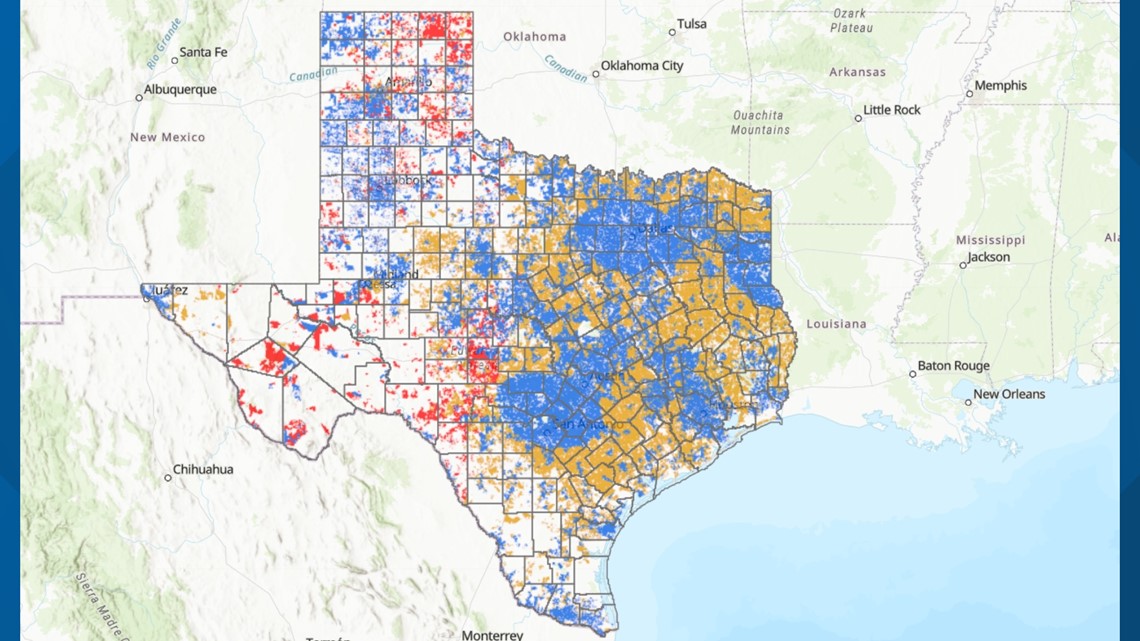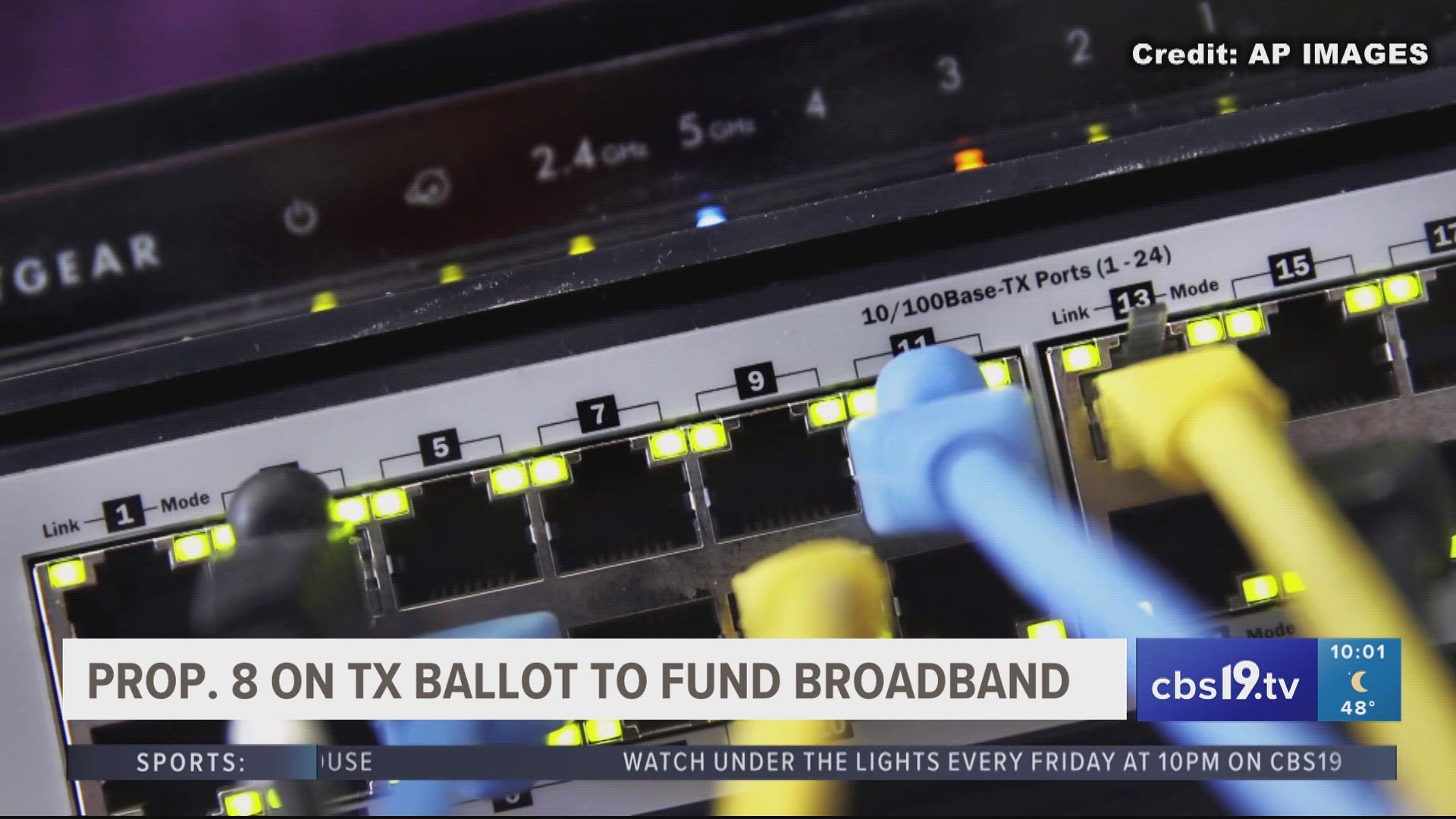TYLER, Texas — What once was a luxury is now a necessity for many in today's world, and a lot of East Texans are left out when it comes to having reliable internet access. It powers businesses, connects people around the world and creates avenues for education and health care.
However, broadband internet is not equal. Proposition 8 on Texas' Nov. 7 ballot aims at funding a better future for internet access. This proposition is the constitutional amendment creating the broadband infrastructure fund to expand high-speed broadband access and assist in the financing of connectivity projects.
"What Proposition 8 is going to do is provide more money to go with all that federal money coming down," said Deep East Texas Council of Governments (DETCOG) Executive Director Lonnie Hunt.
Hunt knows the importance of the $3.3 billon on the table for Texans in the November election.
"We live in a region that is greatly underserved and unserved," Hunt said.
The State of Texas would pony up $1.5 billion to improve access in rural areas through Proposition 8. A map from the Texas Broadband Development Office (BDO) shows the underserved populations when it comes to high-speed internet. The BDO defines 'underserved' as "locations where maxspeed is between 25/3 and 100/25 Mbps down/up." Deep East Texas is at the heart of the areas in need.
However, East Texans are challenging how accurate the BDO map is. In an interview with The Texas Tribune, Hudson ISD technology specialist Joan Ragland says she and others are petitioning the information in this map.
“We’re not a third-rate country, but we do have areas out here where we just don’t have internet,” Ragland said. “You look at the map, and it looks like everybody is covered. But everybody is not covered.”


The town of Cushing in Nacogdoches County is in that orange area. Cushing ISD Superintendent Dr. Brandon Enos said the issues with extending students' learning start when they leave school and go home. During the pandemic, students and teachers resorted to using paper packets because internet was unreliable away from the city. Some students did their work from the school parking lot.
Over the last two years, the district has invested in nearly $400,000 from personal devices to the expansion of access points within campuses.
"We’re excited about that but that doesn’t help them when they go home. And that’s where the real problem is," Enos said.
The idea of having readily available broadband internet sounds amazing but that doesn't come without strings.
"There's a big problem with it," Enos said. "The federal government money is tied to these companies paying out about 25% of the cost upfront with no guarantee of yield at the end."
These criteria are set by the National Telecommunications and Information Administration (NTIA). They’re working along with the Texas Comptroller’s Office to distribute the grant money to companies who will be laying down the lines to connect the rural areas to the internet.
"We have very few companies who are willing to take a chance on that and hope they get the refunds," Enos said.
The only areas that won't need to pay a 25% match are locations deemed as 'high-cost' to build by the NTIA. They define 'high-cost' as "using a cost model that incorporates an area’s remoteness, population density, topography, and poverty levels, and measures costs over the life of the network. NTIA defined 'area' to mean census block groups."
In East Texas, those areas include southern portions of Sabine County and a sliver of Anderson County as show in this map.
"There won’t be a match there, but really for the most part across the state of Texas there will be," said NTIA Texas federal program officer Jennifer Harris.
But why the match? The NTIA sent CBS19 a statement explaining that the match would, "demonstrate commitment to a particular project and minimize the amount of BEAD program funding spent, which can help extend the reach of the Broadband Equity Access and Deployment Program (BEAD) funding to make sure that everyone in the state has access to reliable, affordable, high-speed Internet service."
ETEX Telephone Cooperative serves northern areas of East Texas. According to their CEO Charlie Cano, 60% of their service area has fiber internet. At their current cash flow, it would take about 10 years for all of their customers to have fiber internet. However, with the grant money, they can cut that time in half.
"Because the rural areas are so spread out, it’s taking us a long time to get to everybody," Cano said. "So just having access is number one is the biggest concern. The sooner we can get to them with some of these grant programs the sooner it’s going to satisfy those concerns."
Cano said ETEX plans on applying for the grant even with the 25% match.
"In our case, we’re going to be able to accelerate the installation and construction broadband fiber optics in East Texas," Cano said.
The NTIA said that the 25% match is an incentive for companies to, "cover as much of the cost as they can through the match to lower the amount of BEAD funding they request, which might make their bid more cost-effective than others for the same project."
In the meantime, solutions are being created to better connect the rural areas of the state to the world wide web.
"We’re trying to create a regional network that will blanket many residents of our region with this high-quality 100 megabit fixed-wireless broadband," Hunt said.
It’s a small solution DETOG is trying to create. For many residents It’ll be their first opportunity to have access to internet service. Right now, the closest thing we have when it comes to broadband internet is Starlink -- a group of satellites around the world that sends internet services to areas of the world where connection is poor or lacking.
"We should be making broadband access a priority in the state," Enos said.
The Texas Broadband Office says they will be releasing an initial proposal this month on how the grant money will be distributed. They urge the public for feedback to make the most out of the grant money. Grant applications will open in 2024.

